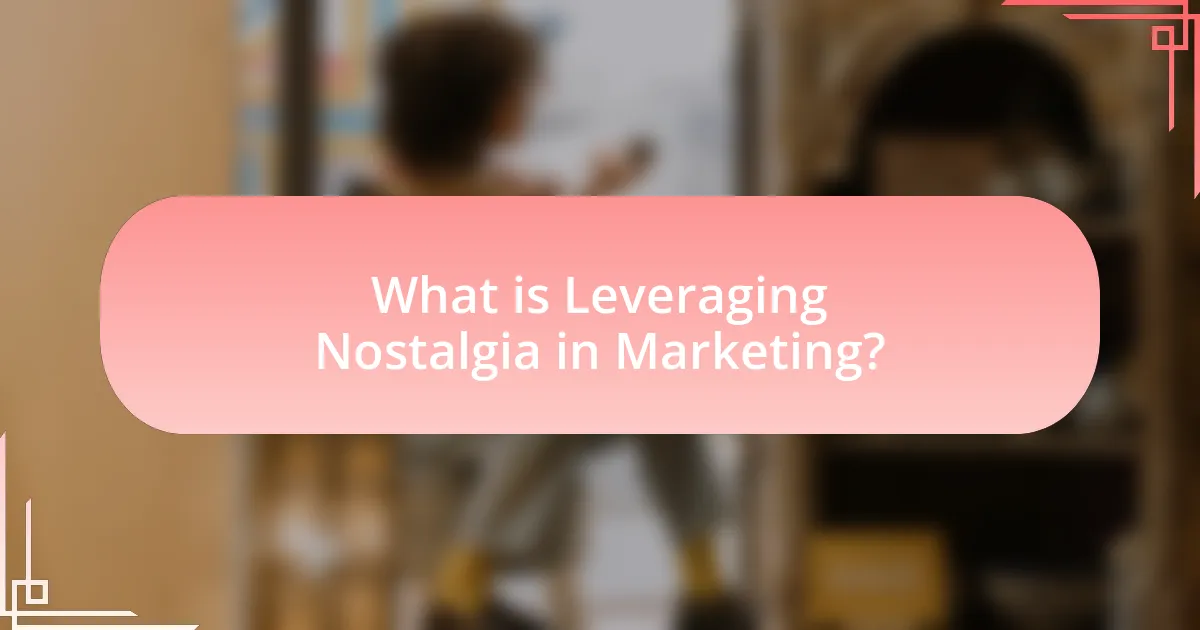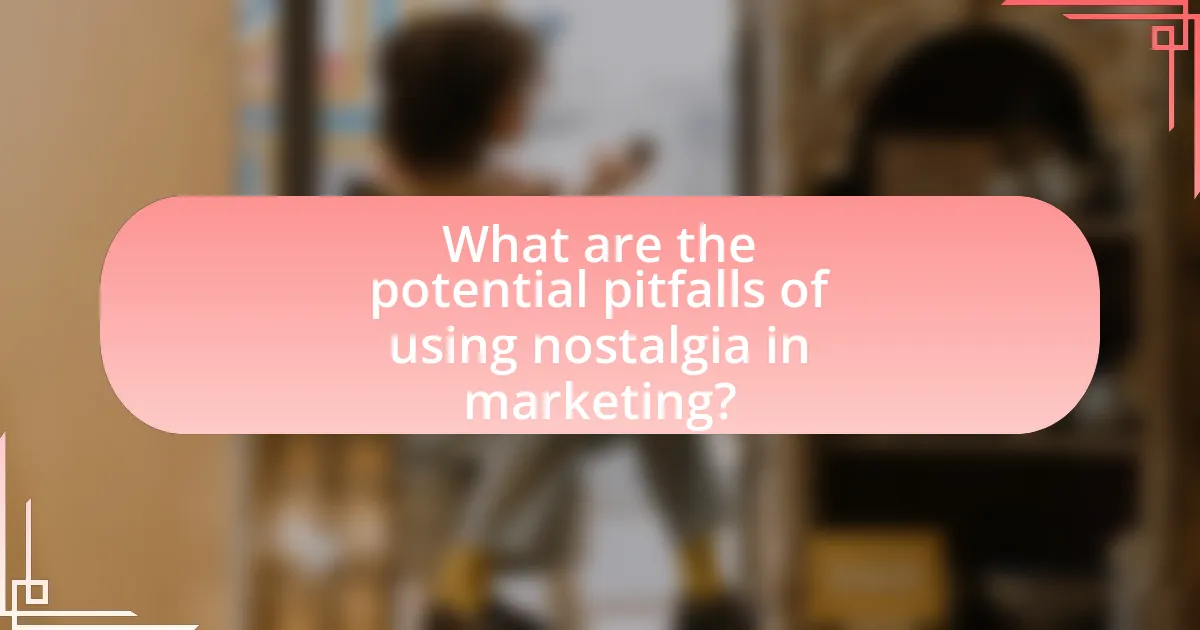Leveraging nostalgia in marketing is a strategic approach that utilizes consumers’ emotional connections to past experiences to influence purchasing decisions. This article explores how nostalgia affects consumer behavior, enhances brand loyalty, and drives purchasing patterns through psychological mechanisms such as memory recall and emotional regulation. It discusses effective techniques for incorporating nostalgic elements into marketing campaigns, including retro branding and storytelling, while also addressing potential pitfalls like alienating younger audiences and ethical considerations. Additionally, the article highlights best practices for measuring the effectiveness of nostalgia-driven campaigns and enhancing their authenticity to foster deeper consumer connections.

What is Leveraging Nostalgia in Marketing?
Leveraging nostalgia in marketing refers to the strategic use of consumers’ fond memories and emotional connections to past experiences to influence their purchasing decisions. This technique taps into the positive feelings associated with nostalgia, which can enhance brand loyalty and consumer engagement. Research indicates that nostalgic marketing can increase consumers’ willingness to pay and their emotional attachment to brands, as demonstrated in studies like “Nostalgia: A Psychological Resource” by Routledge and Arndt, which highlights nostalgia’s ability to foster social connectedness and improve mood.
How does nostalgia influence consumer behavior?
Nostalgia significantly influences consumer behavior by evoking positive emotions and memories that enhance brand attachment and purchasing decisions. When consumers experience nostalgia, they often associate products or brands with cherished past experiences, leading to increased emotional engagement. Research indicates that nostalgic feelings can boost consumers’ willingness to spend, as they seek to recreate or relive those positive memories through their purchases. For instance, a study published in the Journal of Consumer Research found that nostalgia can increase consumers’ preference for familiar brands and products, as it fosters a sense of comfort and belonging. This emotional connection can drive brand loyalty and influence purchasing patterns, making nostalgia a powerful tool in marketing strategies.
What psychological mechanisms are at play when nostalgia is evoked?
Nostalgia is evoked through psychological mechanisms such as memory recall, emotional regulation, and social connectedness. Memory recall activates specific memories associated with past experiences, often leading to a bittersweet emotional state that enhances feelings of warmth and comfort. Emotional regulation occurs as nostalgia helps individuals cope with negative emotions by providing a sense of continuity and meaning in their lives. Additionally, nostalgia fosters social connectedness by reinforcing bonds with others through shared memories and experiences, which can enhance feelings of belonging. Research by Batcho (1995) indicates that nostalgia can serve as a coping mechanism, allowing individuals to navigate present challenges by drawing on positive past experiences.
How does nostalgia affect brand loyalty and purchasing decisions?
Nostalgia significantly enhances brand loyalty and influences purchasing decisions by creating emotional connections between consumers and brands. This emotional bond is rooted in positive memories associated with past experiences, which can lead to increased trust and preference for brands that evoke such feelings. Research indicates that nostalgic marketing can boost consumer engagement; for instance, a study published in the Journal of Consumer Research found that nostalgia can increase consumers’ willingness to pay for products by 12% and enhance their likelihood of purchasing by 20%. This demonstrates that nostalgia not only fosters a sense of belonging but also drives economic behavior, making it a powerful tool in emotional marketing strategies.
Why is nostalgia an effective emotional marketing technique?
Nostalgia is an effective emotional marketing technique because it evokes positive emotions and memories, creating a strong connection between consumers and brands. This emotional resonance can lead to increased brand loyalty and consumer engagement. Research indicates that nostalgic feelings can enhance consumers’ willingness to spend, as demonstrated in a study published in the Journal of Consumer Research, which found that nostalgia can increase the likelihood of purchasing products associated with positive past experiences. By tapping into these cherished memories, brands can foster a sense of belonging and comfort, making nostalgia a powerful tool in marketing strategies.
What are the emotional benefits of using nostalgia in marketing campaigns?
The emotional benefits of using nostalgia in marketing campaigns include enhanced consumer connection, increased brand loyalty, and positive emotional responses. Nostalgia evokes fond memories, which can create a sense of belonging and comfort, leading consumers to feel more positively toward a brand. Research indicates that nostalgic feelings can increase consumers’ willingness to spend, as they associate the brand with positive past experiences. For instance, a study published in the Journal of Consumer Research found that nostalgia can enhance the perceived value of products and increase purchase intentions by fostering emotional warmth and social connectedness.
How does nostalgia create a connection between consumers and brands?
Nostalgia creates a connection between consumers and brands by evoking positive emotions tied to past experiences, which enhances brand loyalty and engagement. When brands incorporate nostalgic elements, such as familiar imagery or references to past cultural moments, they trigger memories that resonate with consumers, fostering a sense of comfort and familiarity. Research indicates that nostalgia can increase consumers’ willingness to pay for products, as seen in a study published in the Journal of Consumer Research, where participants showed a preference for brands that elicited nostalgic feelings. This emotional bond not only strengthens consumer attachment but also encourages repeat purchases and brand advocacy.

What are the key techniques for leveraging nostalgia in marketing?
The key techniques for leveraging nostalgia in marketing include using retro branding, evoking childhood memories, and incorporating familiar cultural references. Retro branding involves reviving old logos, packaging, or products that resonate with consumers’ past experiences, which can enhance brand loyalty; for example, Coca-Cola’s use of vintage designs has successfully attracted nostalgic consumers. Evoking childhood memories can be achieved through storytelling in advertisements that remind consumers of simpler times, as seen in campaigns by brands like Disney, which often tap into the nostalgia of their classic films. Incorporating familiar cultural references, such as music or fashion from past decades, can create an emotional connection with the audience, as demonstrated by brands like Nike, which frequently uses nostalgic elements in their marketing to appeal to consumers’ fond memories.
How can brands effectively incorporate nostalgic elements into their campaigns?
Brands can effectively incorporate nostalgic elements into their campaigns by utilizing familiar imagery, music, and storytelling that resonate with their target audience’s past experiences. For instance, brands can use retro packaging or classic advertising styles that evoke memories from specific decades, such as the 1980s or 1990s, which have been shown to trigger positive emotional responses. Research indicates that nostalgia can enhance consumer attachment to brands, as demonstrated in a study published in the Journal of Consumer Research, where nostalgic advertising led to increased purchase intentions and brand loyalty. By aligning their messaging with shared cultural references and experiences, brands can create a deeper emotional connection with consumers, ultimately driving engagement and sales.
What types of nostalgic content resonate most with consumers?
Nostalgic content that resonates most with consumers includes retro advertisements, classic television shows, and vintage music. These types of content evoke positive memories and emotions associated with the past, leading to increased engagement and brand loyalty. For instance, a study by the Journal of Consumer Research found that nostalgia can enhance consumers’ emotional connection to brands, making them more likely to purchase products linked to nostalgic themes. Additionally, brands that incorporate familiar imagery or references from the past often see higher consumer response rates, as these elements trigger fond memories and a sense of belonging.
How can storytelling enhance the nostalgic experience in marketing?
Storytelling enhances the nostalgic experience in marketing by creating emotional connections that resonate with consumers’ past experiences. When brands use storytelling, they evoke memories and feelings associated with specific times, places, or events, which can trigger nostalgia. Research indicates that nostalgia can increase consumers’ emotional attachment to a brand, leading to higher engagement and loyalty. For instance, a study published in the Journal of Consumer Research found that nostalgic storytelling can enhance consumers’ willingness to pay for products, as it fosters a sense of belonging and comfort. By effectively weaving personal or collective narratives into their marketing strategies, brands can tap into these powerful emotional responses, making their messages more impactful and memorable.
What role does visual and auditory nostalgia play in marketing?
Visual and auditory nostalgia plays a significant role in marketing by evoking emotional connections that enhance brand loyalty and consumer engagement. Marketers utilize nostalgic imagery and sounds to trigger memories associated with positive experiences, which can lead to increased purchasing behavior. For instance, a study published in the Journal of Consumer Research found that nostalgia can increase consumers’ willingness to spend money, as it fosters a sense of belonging and comfort. By incorporating familiar visuals, such as retro designs or iconic music from past decades, brands can create a powerful emotional resonance that influences consumer decisions and strengthens brand identity.
How can brands use music and imagery to evoke nostalgia?
Brands can use music and imagery to evoke nostalgia by selecting familiar sounds and visuals that resonate with specific memories from the target audience’s past. For instance, using popular songs from a particular decade can trigger emotional responses linked to that time, as studies show that music is closely tied to memory recall. Additionally, imagery that reflects cultural icons, fashion trends, or significant events from the past can enhance this effect, as research indicates that visual stimuli can evoke strong emotional connections. By combining these elements, brands can create a powerful nostalgic experience that fosters consumer loyalty and engagement.
What are some examples of successful nostalgic advertising campaigns?
Some examples of successful nostalgic advertising campaigns include Coca-Cola’s “Share a Coke” campaign, which personalized bottles with popular names, evoking memories of childhood and social connections. Another notable example is Apple’s “1984” Super Bowl ad, which referenced George Orwell’s dystopian novel to position the Macintosh as a revolutionary product, tapping into cultural fears and aspirations. Additionally, the “Back to the Future” campaign by Pepsi, which featured the iconic DeLorean car, successfully leveraged nostalgia for the beloved film franchise, appealing to fans’ fond memories. These campaigns effectively utilized nostalgia to create emotional connections, resulting in increased brand engagement and sales.

What are the potential pitfalls of using nostalgia in marketing?
The potential pitfalls of using nostalgia in marketing include alienating younger audiences, oversimplifying complex emotions, and creating unrealistic expectations. When brands rely heavily on nostalgia, they may fail to resonate with consumers who do not share the same memories or experiences, leading to disengagement. Additionally, nostalgia can evoke a sense of longing that oversimplifies the emotional landscape, potentially resulting in disappointment if the product does not meet the idealized standards set by past experiences. Furthermore, marketing campaigns that hinge on nostalgic themes may inadvertently set high expectations, which can lead to customer dissatisfaction if the current offering does not live up to the nostalgic promise.
How can nostalgia backfire in marketing strategies?
Nostalgia can backfire in marketing strategies by alienating younger audiences who do not share the same memories or emotional connections. When brands rely heavily on nostalgia, they risk creating a disconnect with potential customers, leading to decreased engagement and sales. For instance, a study by the Journal of Consumer Research found that nostalgia can evoke positive feelings, but if the target demographic lacks familiarity with the referenced era or product, it may result in confusion or indifference. This misalignment can ultimately harm brand perception and limit market reach.
What are the risks of alienating younger audiences with nostalgia?
Alienating younger audiences with nostalgia can lead to disengagement and a loss of relevance. When brands focus excessively on nostalgic elements that resonate primarily with older demographics, they risk creating content that younger audiences find unrelatable or outdated. This disconnect can result in decreased brand loyalty and diminished market share, as younger consumers may seek alternatives that better reflect their values and experiences. Research indicates that 70% of millennials prefer brands that engage them in a meaningful way, highlighting the importance of relevance in marketing strategies. Therefore, neglecting the preferences of younger audiences in favor of nostalgia can ultimately undermine a brand’s ability to connect with a key consumer segment.
How can over-reliance on nostalgia lead to brand stagnation?
Over-reliance on nostalgia can lead to brand stagnation by limiting innovation and failing to engage new audiences. When brands excessively focus on past successes or familiar themes, they risk alienating younger consumers who may not resonate with those nostalgic elements. For instance, a study by the Journal of Consumer Research indicates that while nostalgia can evoke positive emotions, it may also create a comfort zone that discourages brands from evolving their offerings. This stagnation can result in decreased market relevance, as brands that do not adapt to changing consumer preferences may struggle to maintain their competitive edge.
What ethical considerations should marketers keep in mind when using nostalgia?
Marketers should prioritize authenticity and avoid manipulation when using nostalgia in their campaigns. Authenticity ensures that the nostalgic elements resonate genuinely with the target audience, fostering trust and emotional connection. Manipulation, on the other hand, can exploit consumers’ emotions, leading to feelings of regret or loss, which can damage brand reputation. Research indicates that nostalgia can evoke strong emotional responses, but ethical marketing practices require transparency and respect for consumer sentiments. For instance, a study published in the Journal of Consumer Research highlights that while nostalgia can enhance brand attachment, it must be used responsibly to avoid misleading consumers about product benefits or brand history.
How can brands ensure they are respectful in their nostalgic messaging?
Brands can ensure they are respectful in their nostalgic messaging by conducting thorough research to understand the historical context and emotional significance of the memories they evoke. This approach helps brands avoid trivializing or misrepresenting important cultural moments. For instance, brands should engage with communities that hold these memories to gain insights and perspectives, ensuring that their messaging resonates authentically and respectfully. Additionally, brands can focus on positive aspects of nostalgia that celebrate shared experiences rather than exploiting sensitive or painful memories. This method aligns with findings from studies indicating that nostalgia can enhance brand loyalty when it is approached thoughtfully and respectfully.
What are the implications of manipulating nostalgia for profit?
Manipulating nostalgia for profit can lead to significant emotional engagement and consumer loyalty, but it also risks ethical concerns and potential backlash. Companies that effectively evoke nostalgic feelings can enhance brand attachment, as evidenced by studies showing that nostalgia can increase consumer spending by up to 20%. However, over-commercialization of nostalgia may alienate consumers who feel exploited, leading to negative brand perception. For instance, brands like Coca-Cola have successfully used nostalgia in campaigns, but missteps can result in public criticism, as seen with certain retro-themed products that failed to resonate authentically with their target audience. Thus, while nostalgia can be a powerful marketing tool, its manipulation must be approached with caution to avoid damaging brand integrity.
What best practices should marketers follow when leveraging nostalgia?
Marketers should focus on authenticity, emotional connection, and targeted messaging when leveraging nostalgia. Authenticity ensures that the nostalgic elements resonate genuinely with the audience, as consumers are more likely to engage with brands that reflect their true experiences. Emotional connection can be achieved by tapping into shared memories or cultural references that evoke positive feelings, enhancing brand loyalty. Targeted messaging involves understanding the specific demographics that relate to the nostalgic elements, as different age groups may have varying associations with past events or trends. For instance, a study by the Journal of Consumer Research found that nostalgia can increase consumer spending by 20%, demonstrating the effectiveness of these practices in driving engagement and sales.
How can brands measure the effectiveness of nostalgia-driven campaigns?
Brands can measure the effectiveness of nostalgia-driven campaigns through various metrics such as engagement rates, sales performance, and consumer sentiment analysis. Engagement rates can be assessed by tracking social media interactions, shares, and comments related to the campaign, indicating how well the nostalgic elements resonate with the audience. Sales performance can be evaluated by comparing sales data before, during, and after the campaign, providing concrete evidence of its impact on purchasing behavior. Additionally, consumer sentiment analysis can be conducted through surveys and feedback mechanisms to gauge emotional responses, revealing how nostalgia influences brand perception and loyalty. Research indicates that nostalgia can enhance emotional connections, leading to increased customer loyalty and higher sales, as shown in studies like “The Influence of Nostalgia on Consumer Behavior” by Wildschut et al., which highlights nostalgia’s positive effects on consumer attitudes and behaviors.
What strategies can enhance the authenticity of nostalgic marketing efforts?
To enhance the authenticity of nostalgic marketing efforts, brands should focus on genuine storytelling that resonates with the target audience’s past experiences. This involves using real historical references, such as popular culture elements from specific decades, to create a relatable context. For example, incorporating iconic music, fashion, or events from the 1980s can evoke strong emotional connections, as studies show that nostalgia is linked to positive feelings and memories (Batcho, 1995). Additionally, engaging with the audience through user-generated content, where consumers share their own nostalgic stories related to the brand, can further reinforce authenticity. This strategy not only validates the brand’s message but also fosters community and connection among consumers, making the nostalgic marketing effort more impactful.


